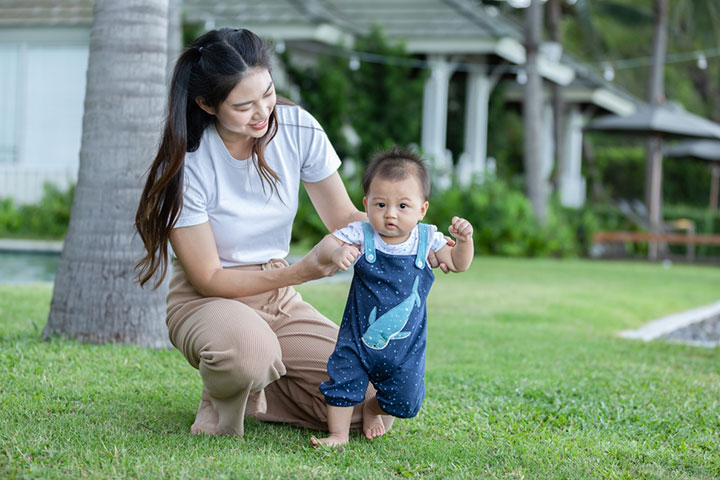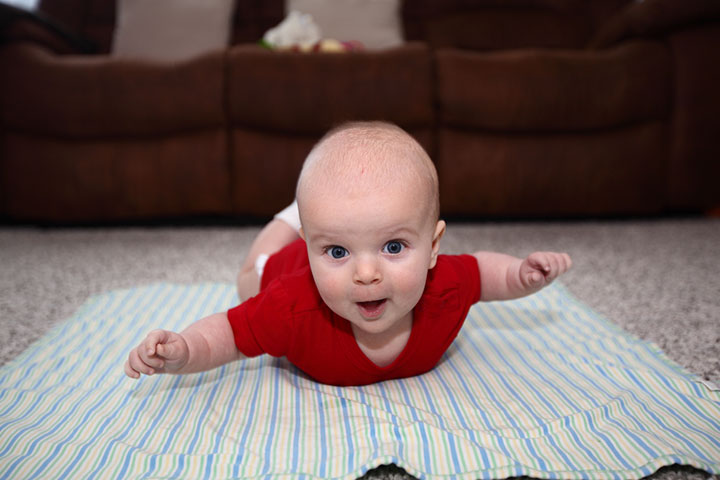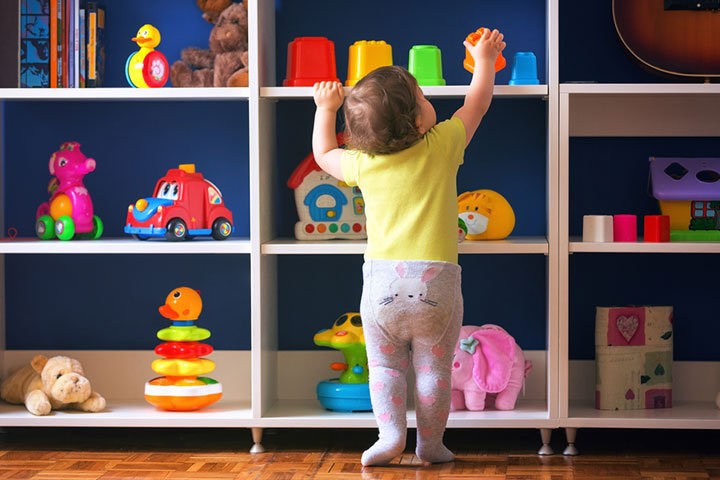When do babies stand can be a common query among parents and caregivers since they want to know if there is any delay. Motor skills including the ability to ambulate have a key role in development, and it allows independent movements in infants.Crawling, rolling, standing, walking, running, and jumping are common motor skills, and a baby reaches these milestones at various stages of their development. Knowing when babies stand can help the parents ensure that their baby meets the milestone on time.
Read on to know the answer for when do babies stand, signs of readiness to stand, and ways to stimulate it.
Is Your Baby Ready To Stand?
Getting ready to stand is a gradual process and involves the prior achievement of several motor skills. It means your baby will achieve different milestones, such as rolling, sitting, getting on all fours, crouching, and crawling, which will develop muscle strength and coordination required for standing.
The following are some essential gross motor skills and the ages at which a baby would generally achieve them (1) (2).
- Four months: May roll from tummy to back
- Six months: Rolls from tummy to back and back to tummy, and sits without support
- Nine months: Gets into sitting position and starts crawling
Once your baby sits and begins to crawls, you can expect them to stand up as they grow older. Besides, there are other signs that may indicate that the baby is ready for standing.
- Scooting on the floor
- Bearing weight on legs when held upright
- Kneeling and trying to pull and lift feet to stand
- Showing interest in standing and grasping objects that are kept at a height
When Do Babies Usually Stand?
According to the Centers for Disease Control and Prevention (CDC), babies learn to stand between the ages of eight and 12 months. The baby becomes completely independent at standing between the ages of 12 and 18 months (2).
The achievement of standing happens in phases. The following are the various standing-related milestones and the usual age range of achievement.
- 6 to 8 months: The baby can stand when held but may not support their entire body weight on their feet, so you need to hold them so they don’t sway and fall. Most babies tend to bounce on their legs when held in the standing position.
- 9 to 11 months: The infant begins to pull to stand and even stand while they hold on to a support. When held in a standing position by a parent, the baby may wobble but they will be able to support most of their body weight on their legs.
Mother of an 11-month-old, Phillippa Banister shares that even though her baby couldn’t stand properly, she tried to do so in her own ways. “She has, in her own way, begun to move. In a variety of yoga-inspired moves (yoga started with babies, right?!), she leans over with one leg poised to push herself forward but the other trapped in front. A pigeon pose, if you will… but she does still manage to move from one place to another, at times without any evidence of how she did! She slides, she shuffles, she leans — doubling over to reach a colorful block or plant leaf that’s just out of reach (or not!) (i),” she says.
- 12 to 17 months: It is the age when toddlerhood begins. The toddler will pull to stand and may toddle, that is, take a few unsteady steps while holding on to objects for support. Some toddlers may even take a few wobbly steps without holding on. However, the toddler may not stand or engage in toddling for too long.
- 18 months: The toddler is now adept at standing and walking without support for a longer duration. Some toddlers may walk up a flight of stairs and run.
Each child is different and may achieve these milestones at a different age. Do not panic if your baby’s motor skills do not match up with their peers. Speak to a pediatrician if you have any doubts.
If the baby has a healthy growth and has achieved all of their previous developmental milestones, they will eventually attain the ability to stand. Nevertheless, it is good to know any signs of developmental delay.
Signs Of Delayed Development
Since the ability to stand requires the achievement of different motor skills, you need to check the delay of other motor skills, too. Below is the list of the possible red flags that may indicate developmental delay at different ages (3) (4).
| By 9 months |
|
|---|---|
| By 12 months |
|
| By 18 months |
|
If you notice any of the above-mentioned signs, do not hesitate to speak to a pediatrician. Early intervention could help in the timely diagnosis and treatment of any developmental delay.
How To Encourage Infants To Stand On Their Own?
Most babies achieve various motor skills through the course of their growth and may not require any help. Nevertheless, parents can exercise and stimulate a baby’s motor skills to help them develop better.
Below are a few tips that you may consider to encourage a baby to move forward and elevate their ability to stand on their own.
- Tummy time:According to the American Academy of Pediatrics, babies need tummy time to develop strong muscles (5). It lays the foundation for various motor skills. Newborns can play on their tummy for about five minutes multiple times a day. As the baby grows older, you can increase the amount of tummy time.
- Support standing: Once the baby is six months old, you can hold them upright in a standing position. Support the baby by placing your hands under their arms. Encourage the baby to bounce on their legs while their feet are on the ground. It makes for a good exercise for their leg muscles.
- Encourage pull to stand: A baby will pull to stand from the age of nine months. Place sturdy furniture and toys that can bear the baby’s weight and allow them to stand while taking support. Research shows that the baby is likely to stand without support for longer when given an attractive toy to hold as encouragement (6).
- Play games: You can try several games and activities that would require the baby to pull to stand or stand in one place without support. For instance, you may hold a toy at a height that would require them to stand and reach out for it.
- Support cruising: A 12-month-old will cruise, that is, walk with support. You can encourage cruising by holding the toddler’s hand and supporting them while they walk. Keep the baby barefoot when cruising indoors since it will help the little one learn how to balance, stabilize, and stand on their feet better.
Before trying any activity, make sure you baby-proof your house. Keep sharp and other dangerous objects away from the baby’s reach. Also, avoid placing heavy showpieces that may fall down when the baby pulls to stand while holding a piece of furniture. There are several toys that let a baby pull to stand. Make sure the toy can support the baby’s weight. Never use baby walkers since it may topple and cause accidents (7).
It is a significant milestone for babies to learn to stand by themselves. Parents of young babies may often wonder when do babies stand. Standing is an essential motor skill and is a first step towards the lifelong journey of walking, running, dancing, and much more. Each baby takes their own time to reach their milestone. Do not worry if your baby is delayed by a few weeks. However, if you are very concerned about them not standing, you may consult a pediatrician. The doctor may guide you through various exercises and activities that can assist your child to achieve the milestone sooner.
Key Pointers
- To gain muscle strength for standing, your baby should reach various milestones, such as rolling, crawling, and sitting.
- Babies start standing between 8 and 12 months and are become independent by 18 months.
- If your infant cannot stand or walk without assistance by 12 months, it could be a sign of developmental delay.
- You can support your baby to stand in the beginning to encourage them.
Learn the safest, most effective way to help your baby stand with this helpful video! Get tips on how to encourage your baby to stand and develop their motor skills.















